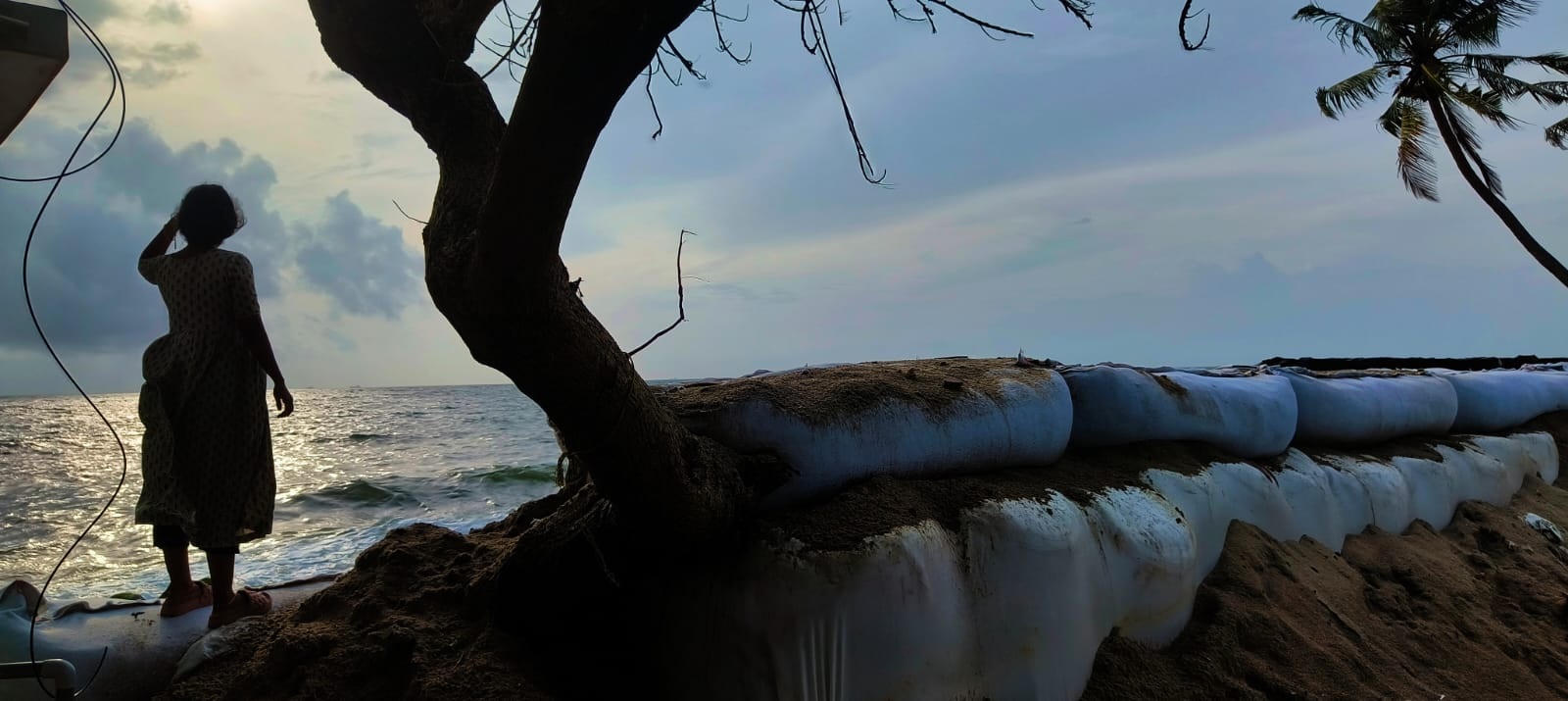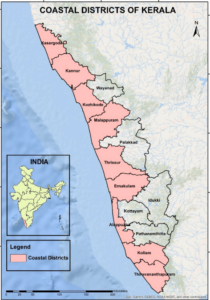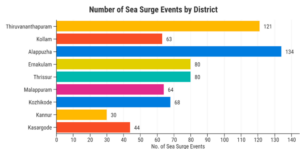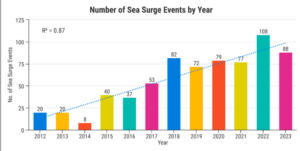A first-of-its-kind study pointed out that the variations in sea surge events across Kerala's coastal districts were shaped by a complex interplay of natural and human-induced factors.
Published Dec 13, 2024 | 9:00 AM ⚊ Updated Dec 13, 2024 | 9:00 AM

The study noticed increasing instances of sea surge along the Kerala coast. (Sreelakshmi Soman/South First).
Kerala’s 590-km-long picturesque coastline is facing a growing menace of sea surge.
A study has identified 11 major hotspots, 14 secondary, and 39 localised hotspots along the state’s nine coastal districts.
The study, carried out by a group of researchers from the Kerala University of Fisheries and Ocean Studies and the Kerala Agricultural University and published in the journal Regional Studies in Marine Science, offered a groundbreaking analysis of spatiotemporal trends in sea surge events along Kerala’s coast from 2012 to 2023, identifying critical hotspots that demand urgent attention.
A sea surge refers to the temporary rise in sea level along a coastline, typically caused by meteorological and/or oceanographic factors, that can lead to rapid flooding of coastal areas. Researchers say it is not storm surge or coastal flooding.
Among the revelations is the identification of Alappuzha as the most vulnerable district in terms of total sea surge occurrences.

Coastal districts in Kerala.
However, when standardised for coastline length, Ernakulam emerged as the district experiencing the highest frequency of surges, despite having a comparatively shorter coastline.
Spatial analysis revealed 11 statistically significant primary hotspots along Kerala’s coastline.
Additionally, 14 secondary hotspots were identified in the state, offering a multi-layered understanding of the phenomenon.
Going deeper, the study assessed district-level variations. This uncovered 39 hotspot locations across Kerala’s nine coastal districts, highlighting vulnerabilities that are often overlooked in state-level analyses.
These findings underscored the complexity of sea surge patterns and emphasise the need for localised interventions.
One of the major findings of the study was the revelation of a worrisome trend, with the frequency of sea surges increasing significantly.
Nearly 80% of these events occurred during the southwest monsoon months of May to August, underlining a clear seasonal pattern.
The research found that the number of sea surge events fluctuated significantly during the study period from 2012 to 2023. While the number decreased from 20 in 2012 and 2013 to just 8 in 2014, it shot up fivefold to 40 in 2015.

Sea surge events in Kerala.
By 2018, the number had climbed to 82, and a dramatic spike occurred in 2022, with 108 events recorded—the highest in the 12-year study period.
Though there was a moderate decline to 88 events in 2023, the overall trend remains concerning, indicating increased variability in sea surge occurrences.
When comparing the first half of the study period (2012–2017) to the latter half (2018–2023), the cumulative number of sea surge events nearly tripled across Kerala’s nine coastal districts.
Ernakulam witnessed the most alarming rise, with a fivefold increase, followed by Kollam with nearly a fourfold rise. Other districts also reported significant increases, ranging from 1.7 to 2.9 times.
The month-wise analysis highlighted that nearly 80% of sea surge events occurred between May and August, peaking in July, followed by June.
However, the study also noted sporadic occurrences in other months.
Sea surges were found to be short-lived, typically lasting one to four days at a given location, and occurred on distinct days rather than continuously throughout the month.
The study pointed out that the variations in sea surge events across Kerala’s coastal districts were shaped by a complex interplay of natural and human-induced factors.
Coastal topography, wind patterns, storm tracks, tidal forces, and ocean currents combined with elements like coastal vegetation, land use, and anthropogenic activities such as coastal engineering, mining, dredging, and construction all played a role in it.
“When comparing our findings with studies from other coastal regions, including insights from the Intergovernmental Panel on Climate Change (IPCC) Report 2021, we discovered that Kerala’s surge patterns mirror global trends,” the study noted.
“These trends highlight the growing frequency and intensity of coastal hazards, fuelled by climate change and human interference in natural systems. Even more concerning, this trajectory signals not just present challenges but a looming escalation of risks for the future,” it added.
The study offered crucial insights into the regional impacts of climate change, with surges typically lasting one to four days and occurring intermittently. It underscored the urgency of developing advanced forecasting models and tailored coastal management strategies.

Sea surge events in Kerala.
Researchers identified 11 primary and 14 secondary sea surge hotspots, emphasising the critical need for proactive disaster preparedness.
Secondary hotspots, the study warned, could escalate into primary ones due to urban expansion, land-use changes, and climate variability.
Additionally, district-specific assessments exposed 39 previously overlooked hotspots, offering a localised lens to address risks more effectively.
The study called for adaptive strategies that combine technological interventions and public awareness campaigns. Proposed measures include smartphone-based early warning systems, AI-enabled drones for hazard mapping, and GPS-equipped fishing boats for real-time tracking.
Remote sirens and other tech-driven tools could significantly bolster community preparedness, the study recommended.
These findings would serve as a wake-up call for policymakers and disaster management authorities.
With the looming threat of climate change, the study urged immediate action to safeguard coastal communities, protect infrastructure, and enhance resilience against future sea surges.
According to researchers, a three-member team consisting of Sanjay Balachandran, Shijo Joseph and Mattada Sreelakshmi, carried out an evidence-based study on sea surges, a phenomenon wreaking havoc on lives, livelihoods, and the coastal environment.
The study is the first of its kind in the state and it will shed new light on this persistent menace.
They pointed out that while past research primarily focused on coastal erosion or case studies of cyclone-induced storm surges, the study bridged a critical knowledge gap by systematically documenting broader patterns of sea surge events.
By analysing diverse data sources, including scientific reports, science publications, conference proceedings, theses, and media reports, the researchers said they have created one of the most comprehensive databases of sea surges in Kerala to date.
(Edited by Majnu Babu).
